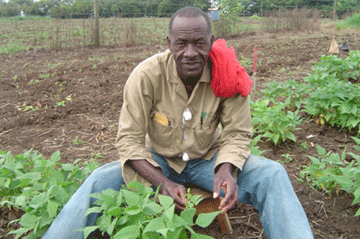|
September, 2008
Source:
CIMMYT E-News, vol 5 no.
9, September 2008
As the food crisis threatens to
worsen micronutrient malnutrition, iron-biofortified pearl
millet and bean are on the fast track for release in Asia and
Africa. Rising food prices mean that poor people are able to
afford fewer nutritious foods like leafy vegetables, fruits and
animal products. As a result, micronutrient malnutrition is
likely to increase.
“Poor people depend mostly on micronutrient-poor staples to
begin with ,” says Howarth Bouis, director of the HarvestPlus
Challenge Program. “It’s not just the quantity of food intake,
but also the quality of that food, that’s important for food
security.”
Iron is one of the critical micronutrients that HarvestPlus is
breeding into staple food crops to improve their nutritional
quality. More than 2 billion people worldwide suffer from
anemia, mostly due to dietary iron deficiency, which can impair
physical growth and mental development and increases the risk of
women dying in childbirth. It has been estimated that more than
half of all pregnant women in developing countries are anemic.
The problem is especially acute in South and Southeast Asia and
tropical Africa, where anemia is linked to poverty.
Bouis, who has done extensive research in the Philippines, has
calculated that, without biofortification and assuming an
overall food price increase of 50%, iron intake among Philippino
women would decline by about 30%. This would mean that only 5%
of Filipino women would meet their daily iron requirements and
that 25% more women would no longer receive the required iron
intake. For more information, see the
IFPRI Blog World Hunger.
“Because of the food crisis, s imilar scenarios will play out
throughout the developing world with dire consequences,” says
Bouis.
 Biofortifying
staple food crops consumed by the poor can help reduce
micronutrient malnutrition by providing a basic “nutritional
floor” upon which other interventions, such as conventional
fortification and supplementation, can build upon. Biofortifying
staple food crops consumed by the poor can help reduce
micronutrient malnutrition by providing a basic “nutritional
floor” upon which other interventions, such as conventional
fortification and supplementation, can build upon.
As the food crisis shows no signs of abating, the HarvestPlus
strategy to develop “fast- to-market” biofortified crops is
especially timely. These staples can be fast-tracked largely
because ,while screening germplasm, plant breeders opportunely
discovered varieties that already contained sufficient
quantities of micronutrients. This means they will not have to
breed specifically for higher nutrient content but can focus
instead on incorporating existing high-nutrient traits into
popular breeding lines. High-iron pearl millet and common bean
are currently being fast-tracked in India and tropical Africa.
Despite many attempts to provide micronutrients in India, severe
micronutrient malnutrition persists among impoverished Indians.
More than 80% of pregnant Indian women are iron deficient. In
western India, where 50 million people commonly grow and eat
pearl millet as a staple, the prevalence of anemia among
children is 66%. HarvestPlus research partners at the
International Centre for Research in the Semi Arid Tropics
screened almost 2,000 pearl millet germplasm accessions and
found varieties with iron levels that well exceeded the target.
Cultivars meeting more than 75% of the iron target are now in
final product development, and the first biofortified varieties
should be in farmers’ fields by 2011. HarvestPlus anticipates
spillover effects in Niger, a West African nation where pearl
millet is an important food crop.
In East Africa, anemia affects more than half of the children in
Rwanda, where 33% of women of reproductive age are anemic. Both
bush and climbing beans are prime sources of protein and
micronutrients in the Rwandan diet. Bean research began in the
first phase of HarvestPlus (2003-2007), with the International
Center for Tropical Agriculture and its national research
partners assaying more than 4,000 bean genotypes. They found
varieties with more than twice the iron content of popular
cultivars. Plant breeders have used these naturally iron-rich
varieties to systematically elevate the iron content of bean
cultivars with each breeding cycle, while maintaining or
enhancing important agronomic traits. They have successfully
developed biofortified varieties that meet 90% of the iron
target and have superior agronomic traits. These varieties will
be field tested next year.
The goal is to provide at least one third of the recommended
daily iron intake for Rwandan women through beans. Pending the
results of nutrition studies that are underway in Rwanda,
HarvestPlus plans to release high-iron beans in 2010 in
collaboration with national partners. While the initial release
will be in Rwanda, at least 10 other African countries stand to
benefit from these new iron-rich bean varieties as they become
more widely available and adapted to different environments.
In just a few years, biofortified varieties of pearl millet and
common bean are expected to provide additional iron to millions
of malnourished people in India and tropical Africa. Early
success with these crops should help pave the way for acceptance
of biofortified “mega-staples” such as maize and rice, which are
already under development and could improve nutrition for
billions more people. |
|